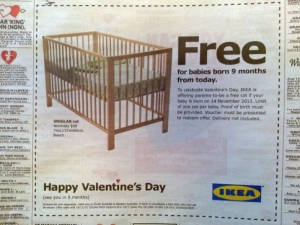
I’ve been meaning to create a new category on the blog in which I could analyse the marketing and public relation strategies and tools used by some of the world’s biggest brand names. KLM is launching a new Airline Tycoon-type game this spring, through which players can create and manage their own airline. Seeing as how this brilliant move to connect with consumers is not the first for KLM, a company that regularly pushes beyond the barriers of social media promotion and marketing, I figure it might just be the perfect brand to begin my new category with.
Starting with a bit of history seems appropriate. That being said, KLM Royal Dutch Airlines, founded in 1919, is one of the oldest airlines in the world that still operates under its original name. KLM received its ‘Royal’ designation by the Dutch Queen before the airline’s establishment. With the introduction of Flying Dutchman in 1991, it was the first European airline to create a frequent flyer loyalty reward scheme. In 2004, KLM merged Air France, giving birth to the KLM Air France Group. Although they form one group, the two companies have kept their separate brand identities. Today, KLM has almost 30,000 employers and annual income of 6.985 million euros at the end of 2011.
1. Contributing to Climate Control
Considering the business of their industry, it’s difficult for airlines to make much of a pitch in issues of climate control. The best strategy would simply be to bring the issue to light rather than fearing to approach it. KLM watches its carbon footprint closely and publicly, and works at developing new technologies for cutting back on CO2 emissions. They even have a CO2 calculator, allowing you to calculate your flight’s carbon emission. The company vows to keep a very open mind towards the environmental impact of air transport by taking measures to reduce energy consumption in the air and on the ground. They collaborate with the World Wide Fund for Nature (WWF) Netherlands, setting strategic goals for their carbon emissions and supporting the WWF’s nature conservation projects. They are also currently supporting a long-term project by the Delft University of Technology, which aims to create CleanEra, an aircraft which will be 50% more efficient and 50% less noisy, by 2025. In 2012, after having announced plans to use recycled cooking oil as biofuel, KLM operated the first trans-atlantic flight to Rio de Janeiro to be partially powered by sustainable fuel. Supporting humanitarian causes is another way through which airlines seem to redeem themselves of their environmental breaches. In 1999, KLM’s charity program AirCares was founded. The sponsorship program raises money for underprivileged children living in countries that KLM flies to and takes donations for different charitable organizations. Getting involved in these charitable organizations is a wise and sensible way for airline companies to make some form of restitution and compensation for their brand image.
2. Making a Brand Impression

The classic KLM blue uniform in the 70’s
KLM’s iconic choice of color makes the brand recognizable around the world. It’s not just their flight attendants that are decked out in the timeless light blue, but also their aircrafts and logo. The KLM logo underwent a series of changes throughout the 1900’s, with the biggest one being in 1961, when F.H.K. Henrion modernized it, turning it into more of the distinguishable logo we all know today. The logo dons a symbolic crown to depict the brand’s royal status. The blue uniform worn by the flight crews makes the brand even more identifiable. Its current edition was created by Dutch designer Mart Visser in 2010, and features a touch of orange to represent the company’s Dutch roots. This was the first time the uniform was revised in 20 years, which comes as no surprise considering how much of a classic and ageless impression their uniforms have always made. KLM doesn’t just understand the importance of making a brand impression, it understands that their impression must illustrate an iconic and traditional message in order to truly resonate and evolve into an excellent reputation. A great example of this is the way they have gifted all their World Business Class passengers since 1952 with small blue and white porcelain traditional Delftware Dutch houses. This was even an inspiration for a biking tour marketing campaign led by KLM, the Netherlands Board of Tourism and Convention, and Amsterdam Schiphol Aiport in the spring of 2011. The lucky winners of the promotional campaign would get the opportunity of biking through a tour of the North or South of Holland, searching for the original versions of the historic porcelain houses. How’s that for a campaign!
3. New ways of using Social Media

Meet & Seat, KLM’s most ingenious campaign so far
KLM has been at the forefront of social media integration in the airline industry, always pioneering marketing campaigns that go beyond usual corporate social media strategies. It’s not just the fact that KLM can be found on Facebook (where they have close to 3 million likes, btw), Twitter, LinkedIn, Foursquare, Youtube, Google+, Pinterest, and Instagram. It’s the fact that KLM strives to make the best and most innovative use of their social media feeds, posting daily and featuring special applications such as the KLM PassportApp. The airline doesn’t just post discounts and special offers. In fact, KLM has been known to lead social media campaigns in a way that not many other companies have managed to. The most recent and renown of these campaigns is the Meet & Seat campaign, which allows passengers to connect their check-in information with their Facebook or LinkedIn profiles so that they could meet someone with similar interests to be seated next to. It is up to the passengers to decide how much information they want to share and if they wish to connect their profiles at all. This campaign is sheer brilliance and could just be the start to something new and greatly innovative in the travel industry, through which people can make business contacts and new friends. Another great social media campaign led by the airline was the KLM Surprise in 2010, which made use of Foursquare in quite a smart new way. The airline used the social media platform to find passengers who were checking in at different KLM locations around the globe. They would track down these passengers and, based on information they had shared on their profiles about themselves and their destinations, give them a special gift. Each gift receiver was photographed and their story was published on the KLM Surprise Facebook page. The campaign was also chronicled on Youtube (see video below). What a fabulous way to connect to the consumer directly while using social media exactly the way it was meant to be used – to learn more about one another! They’ve even found a way to make use of Google Maps, through KLM Must See Map, an app which allows you to create a map for your destination on which your friends can recommend places to see. You can then order a printed version of the map and get it delivered to your door free of charge. Click here for a detailed list of KLM’s social campaigns. They’ve even gotten into the Guinness World Records book for having the highest altitude dance party!
4. Celebrities? Check.

Armin Van Buuren in the Be My Guest campaign
Making use of the image power of celebrities is known to be a clever move by PR professionals. KLM has not skipped out in this aspect either. Their recent Be My Guest Campaign brought passengers the chance to have a virtual chat with one of six famous Dutch celebs (including Armin Van Buuren and Jeroen Krabbe). Based on five questions during their chat, the passenger would enter a competition for the chance to travel with the celebrity. The digital marketing agency that led the campaign, Tribal DDB Amsterdam, even picked up an award for their great work.
5. Developing Consumer Games

KLM’s Piñata Game, offering the chance to win 2 flights to South America
But KLM’s marketing brilliance doesn’t just stop here. They’ve even created several games for their consumers. In August of last year, they created the KLM Piñata Game, which gifted winners with 2 flights to South America. The game wasn’t as easy as it seemed, as the Piñatas dropped from the sky and the wind became quite a challenge. For more fun, you could share the game through social media platforms and even compete with your friends. There was also the Jukebox Journey online music trivia game that targeted consumers over 50. The quiz asked a few music related questions (based on KLM flight locations) and once a question was answered, a destination guide and flight price would be shown. At the end of the game, players could submit their scores for a chance to win flight tickets and also see Spotify links for the songs. It’s impressive how the airline manages to make use of such original ideas in order to offer special discounts and contests that could win the consumer a free flight, while also offering a way to link into social media and targeting different demographics. Another hit was the Stewardess Yourself game, which allowed people to use their photos in order to dress themselves as KLM Stewards, making classic KLM postcards that they could then share with their friends. You could even print out your picture on a tshirt or a mug! The KLM game that is coming out this spring will allow you to run your own airline and discover the difficulties faced by KLM each day as they manage their wide network of flights and locations. See the trailer below:
6. Keeping up with the Tech Trend

The TripShake App allows you to find new destinations by shaking your phone
The airline has also been known for the way it has approached the age of technology, both through its in-flight and ticket technology. KLM was the first airline to install self service transfer kiosks for passengers connecting through the Amsterdam Schiphol airport. These allow passengers to check their flight details and choose or upgrade their seats. In the case of a missed flight, these kiosks allow passengers to choose a new connecting flight and print out their boarding passes. KLM has also engineered a project that enables passengers to drop of their baggage by themselves, through self service baggage drop-off points. This means that together with these drop-off points, passengers can travel to their destination with KLM without even having to interact with any member of staff. Besides the customary airline and mobile check-in app, KLM has now expanded into creating quirky iPhone applications, with the TripShake App, which allows passengers to find new destinations and flight prices just by shaking their phones. And, of course, everything found through the App can be shared through social media. What else would you expect from a company that actually understands social media and the significance of technology in today’s world?




